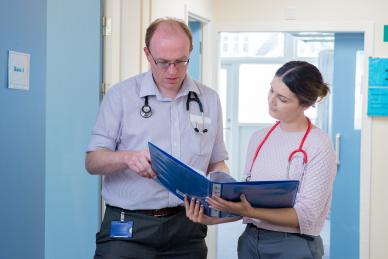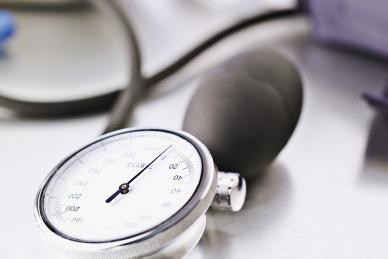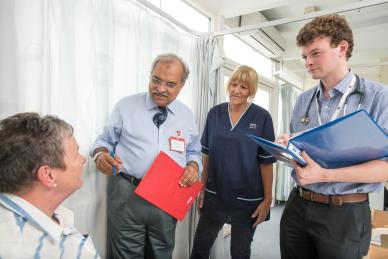Listen to our Respiratory Medicine Podcast Episode
In Career Conversations, Dr Marilena Giannoudi discusses a career in Respiratory Medicine with Dr Natalie Farmer.
Empowering medical excellence, shaping healthcare futures.
There is constant variety, in your patients (from young adults through to advanced age), their pathologies (acute infections to chronic illnesses), and the setting (inpatient and outpatient)
Respiratory often prides itself on taking responsibility for its patients throughout their journey, particularly in supporting their palliative symptoms towards the end of life. This can be very rewarding, particularly as you get to know patients with chronic conditions across inpatient and outpatient interactions
There is plenty of acuity to keep it exciting, but there are also opportunities for deep thinking and close working with other specialties, particularly for complex and challenging cases
Plenty of practical procedures
There are few medical emergencies that you will not ultimately feel competent to manage by the end of training
It is important to find time to complete your admin (clinic letters; portfolio requirements) alongside all of the clinical requirements; there is not always sufficient time allocated for this
Being competent at things other specialties are less confident in (particularly pleural procedures) can make it harder to hand over at the end of the day (but most pleural procedures should not be done out-of-hours anyway!)
Dr Benedict Warner - ST6.
"Respiratory Medicine is a truly generalist specialty: although it is an ‘organ-specific’ specialty, it deals with many non-specific symptoms and often takes the lead on investigating multisystem conditions."

I love the generalism of respiratory- the wide array of problems you may encounter, and the opportunity for truly clinical medicine, which may use a range of investigations but ultimately depends on consideration of the patient in their context. It is a specialty with an ethos of commitment to the patient, and the willingness to take on the care of patient in the presence of uncertainty – something for which many patients are grateful. The practical procedures provide a satisfying challenge, but the opportunities for the greatest advances in Respiratory Medicine may be made through looking beyond the walls of the hospital to public health, for example tackling smoking and air pollution. This is very much an area that a Respiratory Physician may become involved in, either as an academic or as an advocate for their patients.
Engagement with the specialty at any stage in your earlier training is a positive – not only will this demonstrate interest, but it will also allow you to become familiar with the workings of the specialty, and the problems it deals with. Respiratory departments are generally welcoming, and you should be able to attend MDT meetings and procedural lists (bronchoscopy and thoracoscopy) if you can find the time. Take time to talk to the registrars, consultants, and specialty nurses, to learn about how each of their roles contributes to the specialty. Thoracic ultrasound is a big part of the registrar’s role, and attending a course on this during IMT may be helpful, although by no means compulsory. There are many opportunities during IMT to present at regional or national conferences – try to turn any piece of QI or audit work you do into a poster and submit it to trainee conferences such as the RCPE’s annual Medical Training Conference.
The work can be very variable. A typical day can include any combination of the following:



Respiratory Medicine is a truly generalist specialty: although it is an ‘organ-specific’ specialty, it deals with many non-specific symptoms and often takes the lead on investigating multisystem conditions.
It covers a broad range of patients, pathologies, and settings – from acute medical emergencies and critical care, to outpatient management of chronic diseases, to palliative care – often following a patient through the entirety of their inpatient journey, and beyond.
For example, a patient presenting to the acute medical unit with haemoptysis may be seen by Respiratory, who will arrange initial tests, perform invasive investigations such as bronchoscopy and EBUS, and may chair the Lung Cancer MDT. The same patient may then be referred to Oncology, but may be seen again by respiratory to manage complications such as malignant pleural effusions, or ultimately to manage the patient’s symptoms at the end of life. All of this is done in close partnership with a range of allied health professionals, in particular specialist nurses.
Up to 30% of admissions to medical receiving units are for primary respiratory problems, and many medical emergencies seen out-of-hours in hospital are respiratory problems. Respiratory specialists often contribute to the running of Medical High Dependency Units, and have particular expertise in non-invasive ventilation (both acute and chronic). There is scope both for technically satisfying practical procedures, complex patient communication including managing uncertainty, and close multidisciplinary working, particularly with associated specialities including infectious diseases, radiology, cardiology, rheumatology, renal, oncology and cardiothoracic surgery.
The curriculum for Higher Specialty Training in Respiratory Medicine changed in 2022 following the Shape of Training review and the introduction of Internal Medicine Training (IMT). It is an indicative 4-year programme, following completion of either ACCS-IM or IMT (‘indicative’ means that some trainees may take longer to achieve the necessary competencies, and in theory some may achieve them in a shorter timeframe, though this is rare). Less-than-full-time training is entirely possible within the specialty.
It is a ‘Group 1’ specialty, which means that it must be combined with dual certification in Internal Medicine. This takes the form of approximately 12 months of internal medicine training during the 4 years, although this may be reflected in different ways in different deaneries.
It is also possible to ‘triple accredit’ in Intensive Care Medicine, along with Respiratory and Internal Medicine, although this requires careful communication with local Training Programme Directors, and extends the indicative timeframe for the training programme (including IMT/ACCS) to 8.5 – 9.5 years.
Trainees will often spend their first 1 – 2 years becoming familiar with the management of common respiratory problems – including pleural disease, COPD and asthma, suspected lung cancer, interstitial lung disease and respiratory infections – through inpatient ward rounds on the respiratory ward, reviewing inpatient referrals from other specialties, and outpatient clinics. In their later years, rotations through specialist units such as pulmonary vascular units (e.g. the Scottish Pulmonary Vascular Unit in Glasgow), lung transplant units, and cystic fibrosis clinics, will cover sub-specialty areas. Trainees usually contribute to the acute medical take throughout all this, as the ‘medical registrar’ on call.
Entry to Respiratory Medicine requires completion of the 3-year Internal Medicine Training (IMT) programme, or the 4-year Acute Care Common Stem – Internal Medicine (ACCS-IM) programme, and for the candidate to have passed the MRCP(UK) exam.
During their Respiratory training, trainees will have to pass the MRCP(UK) Respiratory Specialty Certificate Examination (SCE).
Trainees will need to maintain their ePortfolio, through the usual supervised learning events (SLEs). They will need to demonstrate engagement in quality improvement work, teaching, and, by the end of training, management. They must complete a patient survey of anonymous feedback from patients twice during the training programme.
In addition, they are required to develop competence in the following practical areas:
Other procedures require familiarity but not necessarily independent competence, although trainees may well develop this as an area of special interest. These include:
Respiratory medicine has always had close links with academia. Time out of programme for dedicated research (OOPR) is common, although by no means a requirement. There is a breadth of research opportunities from basic science, to epidemiological and clinical research. Most trainees who take time OOPR will complete a higher degree (such as an MD or PhD). Often it is possible to count some of the time OOPR towards your clinical training.

In Career Conversations, Dr Marilena Giannoudi discusses a career in Respiratory Medicine with Dr Natalie Farmer.